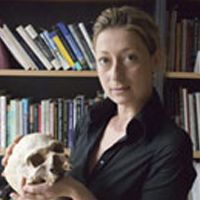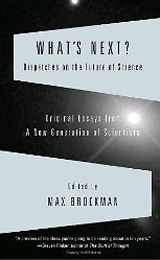What's Next?
Dispatches on the Future of Science
(Annotated Table of Contents)

Max Brockman: To generate this list of contributors, I approached some of today’s leading scientists and asked them to name some of the rising stars in their respective disciplines: those who, in their research, are tackling some of science’s toughest questions and raising new ones. The list that resulted amounts to a representative who’s who of the coming generation of scientists.
MAX BROCKMAN is a literary agent at Brockman, Inc.. He also works with Edge Foundation, Inc., a nonprofit foundation that publishes Edge. A graduate of the University of Pennsylvania in 2002, he lives in New York City.

LAURENCE C. SMITH is Professor and vice chairman of geography and professor of earth and space sciences at UCLA. He studies likely impacts of northern climate change including the economic effects in the Northern Rim.
Further Reading on Edge:
Will We Decamp For the Northern Rim?


Nick Bostrom, a philosopher and director of the Future of Humanity Institute at Oxford University. His research covers issues in the foundations of probability theory, global catastrophic risk, the ethics of human enhancement, and the effects of future technologies.

Sean Carroll: The early universe is hot and dense; the late universe is cold and dilute. Well...why is it like that? The truth is, we have no idea.
Sean Carroll, theoretical physicist, is a senior research associate at Caltech. His research ranges over a number of topics in theoretical physics, including cosmology, field theory, particle physics, and gravitation. He is the author if a graduate textbook, Spacetime and Geometry: An Introduction to General Relativity and cofounder and contributor to the Cosmic Variance blog.

Stephon H. Alexander: Dark energy, itself directly unobservable, is the most bewildering substance known, the only "stuff" that acts both on subatomic scales and across the largest distances in the cosmos.

Sarah-Jayne Blakemore: Using modern brain-imaging techniques, scientists are discovering that the human brain does indeed change well beyond early childhood. Sarah-Jayne Blakemore is a Royal Society University Research Fellow at the Institute of Cognitive Neuroscience, University College London.Her research focuses on the development of mentalizing, action understanding, and executive function during adolescence, using a variety of behavioral and neuroimaging methods.
Jason P. Mitchell: Perhaps the least anticipated contribution of brain imaging to psychological science has been a sudden appreciation of the centrality of social thought to the human mental repertoire.
Jason P. Mitchell is principal investigator of Harvard University's Social Cognitive and Affective Neuroscience Laboratory, where he uses functional neuroimaging (fMRI) and behavioral methods to study how perceivers infer the thoughts, feelings, and opinions of others.

Matthew D. Lieberman, an associate professor of psychology at UCLA, conducts research in such social cognitive neuroscience topics as self-control, self-awareness, automaticity, social rejection, and persuasion

Joshua D. Greene: People often speak of a "moral faculty" or a "moral sense," suggesting that moral judgment is a unified phenomenon, but recent advances in the scientific study of moral judgment paint a very different picture.
Joshua D. Greene, a cognitive neuroscientist and a philosopher, is an assistant professor at Harvard University's Department of Psychology. His primary research interest is the psychological and neuroscientific study of morality, focusing on the interplay between emotional and "cognitive" processes in moral decision making.

Lera Boroditsky: Language is a uniquely human gift, central to our experience of being human. Appreciating its role in constructing our mental lives brings us one step closer to understanding the very nature of humanity.
Lera Boroditsky is an assistant professor of psychology, neuroscience, and symbolic systems at Stanford University. Her research centers on the nature of mental representation and how knowledge emerges out of the interactions of mind, world, and language.
Further Reading on Edge:
How Does Our Language Shape The Way We Think?

Sam Cooke: Once we come to understand how our memories are formed, stored, and recalled within the brain, we may be able to manipulate them—to shape our own stories. Our past—or at least our recollection of our past—may become a matter of choice.
Sam Cooke, a postdoctoral associate at the Massachusetts Institute of Technology, is a neuroscientist who probes the biology of memory.

Deena Skolnick Weisberg: The main goal of my research is to discover the nature of the what-if mechanism and how it allows us to create and comprehend fictional worlds.
Deena Skolnick Weisberg is a Postdoctoral Research Associate at the psychology department at Rutgers University. Her research focuses primarily on the cognitive skills underlying the creation and representation of non-real scenarios—particularly stories, games of pretending, and counterfactual situations—and on how those skills mature in child development.

David M. Eagleman: The days of thinking of time as a river—evenly flowing, always advancing—are over. Time perception, just like vision, is a construction of the brain and is shockingly easy to manipulate experimentally.
David M. Eagleman is Director of the Laboratory for Perception and Action at Baylor College of Medicine The Dynamically Reorganizing Brain; and a book of fiction titled Sum
Further Reading on Edge:

Vanessa Woods: In the 6 million years since hominids split from the evolutionary ancestor we share with chimpanzees and bonobos, something happened to our brains that allowed us to become master cooperators, accumulate knowledge at a rapid rate, and manipulate tools to colonize almost every corner of the planet.
Vanessa Woods, author of It's Every Monkey for Themselves, is an award-winning journalist who has a double degree in biology and English from the University of New South Wales. She is a researcher with the Hominoid Psychology Research Group and studies the psychology of bonobos and chimpanzees in Africa.
Further Reading on Edge:
Out of Our Minds: How Did Humans Come Down From The Trees And Why Did No One Follow?

Nathan Wolfe: While viruses have to infect cellular forms of life in order to complete their life cycles, this does not mean that causing devastation is their destiny. The existing equilibrium of our planet is dependent on the actions of the viral world, and their elimination would have profound consequences.
Nathan Wolfe is the Lorry Lokey Visiting Professor of Human Biology at Stanford University and directs the Global Viral Forecasting Initiative. His research combines methods from molecular virology, ecology, evolutionary biology, and anthropology to study the biology of viral emergence.

Seirian Sumner: We would like to know what the conditions and selection pressures were that tipped the ancestors of the eusocial insects over the ledge and down toward eusociality.
Seirian Sumner is a research fellow in evolutionary biology at the Institute of Zoology, Zoological Society of London. Her research focuses on the evolution of sociality—how eusociality evolves and how social behavior is maintained. She has worked with a variety of bees, wasps, and ants from around the world, studying their behavior through observation, experimental manipulation, and molecular analyses, including gene expression.

Katerina Harvati: It is now clear that humans (whether fossil or living) are not immune from biological forces and that extinction was (and, indeed, is) a distinct possibility.
Katerina Harvati is a paleoanthropologist at the Max Planck Institute for Evolutionary Anthropology specializing in Neanderthal evolution and modern human origins. Her research interests include evolutionary theory, the relationship between morphological variation and genetic and environmental factors, and the evolution of primate and human life history.

Gavin Schmidt: Even as scientific output has increased exponentially, concerns have been raised that growing specialization will end by making it impossible for scientists in different fields to communicate, let alone collaborate.
Gavin Schmidt is a climatologist with NASA's Goddard Institute for Space Studies in New York, where he models past, present, and future climate. He is a cofounder and contributing editor of RealClimate.org, which provides context and background on climate science issues that are missing in popular media coverage.


